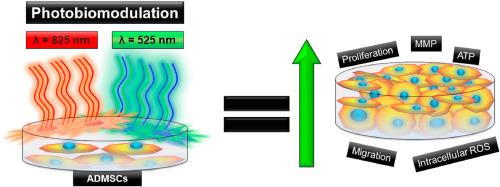Biochimie ( IF 3.3 ) Pub Date : 2021-07-27 , DOI: 10.1016/j.biochi.2021.07.009 Anine Crous 1 , Madeleen Jansen van Rensburg 1 , Heidi Abrahamse 1

|
Regenerative medicine uses undifferentiated adipose-derived mesenchymal stem cells (ADMSCs) to differentiate into multiple cell types. Photobiomodulation (PBM) is a rapidly growing treatment for pain and inflammation reduction, as well as tissue healing. PBM's efficacy is dependent on wavelength and energy dosage. Red (600–700 nm) and near-infrared (780–1100 nm) wavelengths have been shown to promote cell proliferation. Light wavelengths such as green (495 nm–570 nm) have been found to influence ADMSC differentiation. The initiation of ADMSC proliferation and differentiation requires physiologically relevant levels of reactive oxygen species (ROS), while increased levels inhibit self-renewal. Stem cell differentiation is guided by mitochondrial metabolism, where an increased mitochondrial membrane potential (MMP) is associated with higher in vitro differentiation capacity. ADMSCs must home to and accumulate at the sites of injury in regenerative medicine, so cell homing is critical. The aim of this in vitro study was to compare consecutive NIR (825 nm) and green (525 nm) applications on ADMSC morphology and physiology with the possibility that multiple wavelengths could lead to a combination of the two effects. The results showed that concurrent use of NIR-green irradiation significantly stimulated ADMSC proliferation, increasing population density and cellular ATP. Furthermore, NIR-green showed a time dependent increase in ROS production and was significantly higher at 7 days. Consecutive NIR-green irradiation significantly increased MMP and was most effective at facilitating ADMSC migration over time. Findings suggest that with consecutive NIR and green irradiation, the ADMSCs can rapidly proliferate, but can also be modulated for regenerative purposes.
中文翻译:

近红外和绿色照射的单次和连续应用调节脂肪来源的干细胞增殖并影响分化因子
再生医学使用未分化的脂肪来源的间充质干细胞 (ADMSC) 分化成多种细胞类型。光生物调节 (PBM) 是一种快速发展的治疗方法,用于减轻疼痛和炎症以及组织愈合。PBM 的功效取决于波长和能量剂量。已证明红色 (600–700 nm) 和近红外 (780–1100 nm) 波长可促进细胞增殖。已发现绿色 (495 nm–570 nm) 等光波长会影响 ADMSC 分化。ADMSC 增殖和分化的启动需要生理相关水平的活性氧 (ROS),而增加的水平会抑制自我更新。干细胞分化由线粒体代谢引导,其中线粒体膜电位 (MMP) 增加与更高体外分化能力。在再生医学中,ADMSC 必须归巢并聚集在损伤部位,因此细胞归巢至关重要。这个体外的目的研究是比较连续近红外 (825 nm) 和绿色 (525 nm) 应用对 ADMSC 形态和生理学的影响,以及多个波长可能导致两种效应结合的可能性。结果表明,同时使用近红外绿光照射可显着刺激 ADMSC 增殖,增加种群密度和细胞 ATP。此外,NIR-green 显示 ROS 产量随时间增加,并且在 7 天时明显更高。连续的 NIR-green 照射显着增加了 MMP,并且随着时间的推移在促进 ADMSC 迁移方面最有效。研究结果表明,通过连续的 NIR 和绿色照射,ADMSCs 可以快速增殖,但也可以进行调制以实现再生目的。











































 京公网安备 11010802027423号
京公网安备 11010802027423号